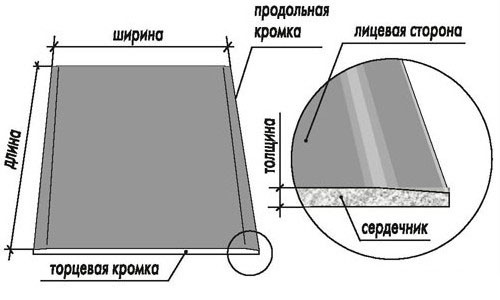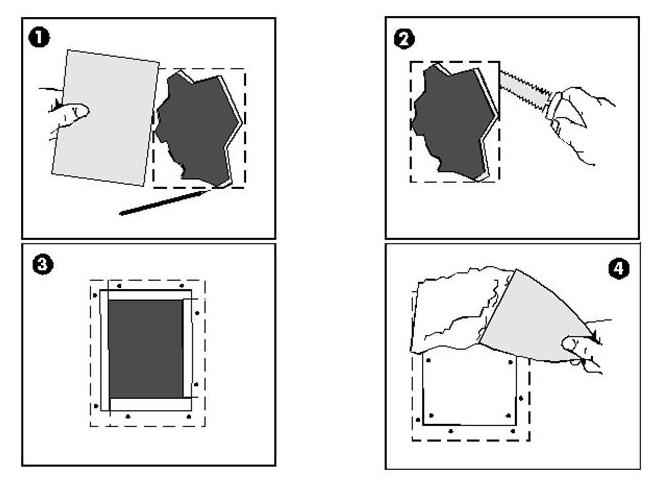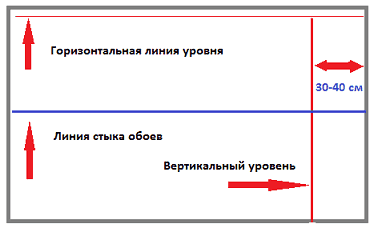Drywall is a modern,technological material. Rarely do repairs go without its use. But it also has a significant drawback: the material is easily damaged by mechanical impact. Many can make a hole in drywall, but the process of sealing it causes difficulties. Having accidentally broken a hole in the sheathing, do not despair. Its sealing will not cause any particular difficulties. The need to restore the surface may also arise after making an extra hole in the drywall. Structure of a plasterboard sheet.
Structure of a plasterboard sheet.
Tools and materials
To repair unexpected damage, you need a small set of tools from the decorator's arsenal. List of tools:
- pencil;
- gon;
- strong knife;
- Hacksaw on the GCR;
- a hacksaw on wood;
- Screwdriver;
- crown for GCR;
- brush;
- putty knife;
- grinding grid holder.
List of materials: Scheme of patching a hole in a plasterboard wall.
Scheme of patching a hole in a plasterboard wall.
- wire;
- panel material;
- self-tapping screws;
- paper;
- primer;
- cutting off the GCR;
- putty;
- ribbon-serpyanka;
- grinding mesh.
Return to Contents</a>
Performance of works
Depending on the size of the hole and the availableThere are different methods for sealing, depending on the tools and materials. Small holes from unnecessary dowels are eliminated by filling with putty. If the hole in the drywall was formed by an impact and has loose, cracked edges of an uneven shape, to seal it you need to cut a larger hole with a clear, even edge. All damaged areas must be removed. Small round elements are cut out with a crown for socket boxes and spotlights. Larger areas are more difficult to cut out. A regular geometric figure is marked on the wall (a rectangle is most convenient), the initial section of the straight line is pierced with a knife and finished with a hacksaw for drywall or, if there is none, with the same knife. To seal an area up to 50 mm in diameter, it is enough to mold a lump of the appropriate size from wet paper and mixed putty and fill the hole with it. The edges of the hole must be primed beforehand. Using a spatula, the patch is leveled flush with the surface. After this patch has hardened, additional treatment of its surface with finishing putty may be required. Schemes for repairing holes in plasterboard.To repair larger damage, you have to use a patch from a piece of plasterboard left over from the repair. Before cutting the hole, you need to prepare a piece of the sheet the size of which covers the damaged area. The piece covers the hole, and its outline is marked on the sheathing with a pencil. You need to cut a hole in the plasterboard along the marked outline. A chamfer is removed with a knife along the edges of the hole and the patch by 2/3 of the sheet thickness. Wooden planks are cut with a hacksaw, the length of which exceeds the size of the hole by 10-15 cm. The planks are inserted into the holes, their edges are fixed with self-tapping screws for plasterboard through it. The number of planks depends on the size of the damage. They are placed in a row with an indentation from the edge of 2-3 cm and at a distance of 20-25 cm from each other. The patch is screwed with self-tapping screws to the planks in the resulting niche. Its perimeter is primed. The joint between the patch and the main sheet is glued with serpyanka and filled with joint putty using a spatula. Another method is also applicable for ceiling damage. You need to prepare a piece of any panel material slightly larger than the dimensions of the window. This can be chipboard, fiberboard, OSB, laminate, MDF wall panels and similar materials. It is better to screw several screws into it in advance so that their heads protrude from the material. A piece of wire is intertwined between them. In the middle of the workpiece, two small holes are made according to the diameter of the wire. A piece of wire is threaded through them. The resulting workpiece is inserted into the cut window. With its oblong shape, this should work. The edges of the niche are primed. In the second panel element, which will be the formwork, you also need to make a hole for threading the hanging ends of the wire. The ends are inserted into it, a portion of putty is applied to the surface of the lower element. The formwork is pressed against the ceiling and fixed in this position by tightening the wire. Excess putty is squeezed out to the sides and removed with a spatula. After hardening, the wire is unraveled. The formwork is knocked to the side. With any method of restoring the integrity of the sheathing, the unevenness on the surface of the hardened putty is cleaned with a sanding mesh. After applying the finishing coat, the repaired area is indistinguishable from the adjacent areas. Only the one who was able to seal it will be able to guess where the hole in the drywall was.</ ul>
Schemes for repairing holes in plasterboard.To repair larger damage, you have to use a patch from a piece of plasterboard left over from the repair. Before cutting the hole, you need to prepare a piece of the sheet the size of which covers the damaged area. The piece covers the hole, and its outline is marked on the sheathing with a pencil. You need to cut a hole in the plasterboard along the marked outline. A chamfer is removed with a knife along the edges of the hole and the patch by 2/3 of the sheet thickness. Wooden planks are cut with a hacksaw, the length of which exceeds the size of the hole by 10-15 cm. The planks are inserted into the holes, their edges are fixed with self-tapping screws for plasterboard through it. The number of planks depends on the size of the damage. They are placed in a row with an indentation from the edge of 2-3 cm and at a distance of 20-25 cm from each other. The patch is screwed with self-tapping screws to the planks in the resulting niche. Its perimeter is primed. The joint between the patch and the main sheet is glued with serpyanka and filled with joint putty using a spatula. Another method is also applicable for ceiling damage. You need to prepare a piece of any panel material slightly larger than the dimensions of the window. This can be chipboard, fiberboard, OSB, laminate, MDF wall panels and similar materials. It is better to screw several screws into it in advance so that their heads protrude from the material. A piece of wire is intertwined between them. In the middle of the workpiece, two small holes are made according to the diameter of the wire. A piece of wire is threaded through them. The resulting workpiece is inserted into the cut window. With its oblong shape, this should work. The edges of the niche are primed. In the second panel element, which will be the formwork, you also need to make a hole for threading the hanging ends of the wire. The ends are inserted into it, a portion of putty is applied to the surface of the lower element. The formwork is pressed against the ceiling and fixed in this position by tightening the wire. Excess putty is squeezed out to the sides and removed with a spatula. After hardening, the wire is unraveled. The formwork is knocked to the side. With any method of restoring the integrity of the sheathing, the unevenness on the surface of the hardened putty is cleaned with a sanding mesh. After applying the finishing coat, the repaired area is indistinguishable from the adjacent areas. Only the one who was able to seal it will be able to guess where the hole in the drywall was.</ ul>


